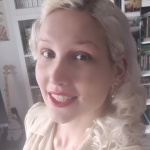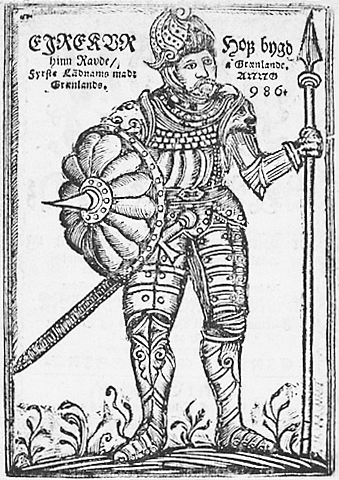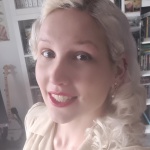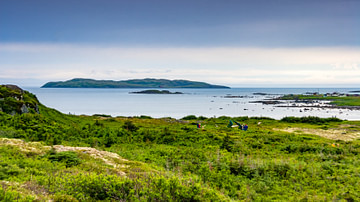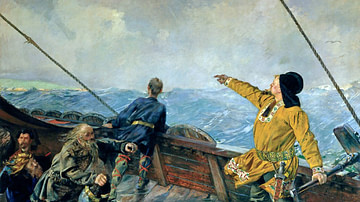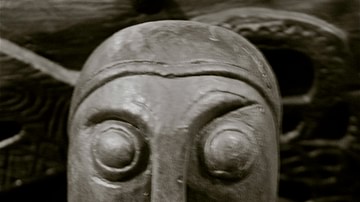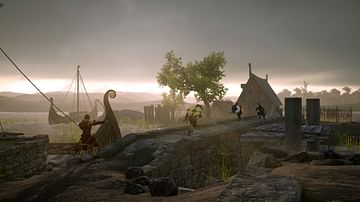Greenland was drawn into the Viking Age and settled by Norse Vikings in the late 980s CE, their presence there lasting into the 15th century CE. Despite its ice-riddled geography, the Norse managed to carve out a living for themselves in these unforgiving lands by seeking out verdant pockets along the south-western coast, founding both the so-called Eastern Settlement (which is located, confusingly, in the south of West-Greenland) and the Western Settlement, some 650 km further north along the west coast in the present-day Nuuk region.
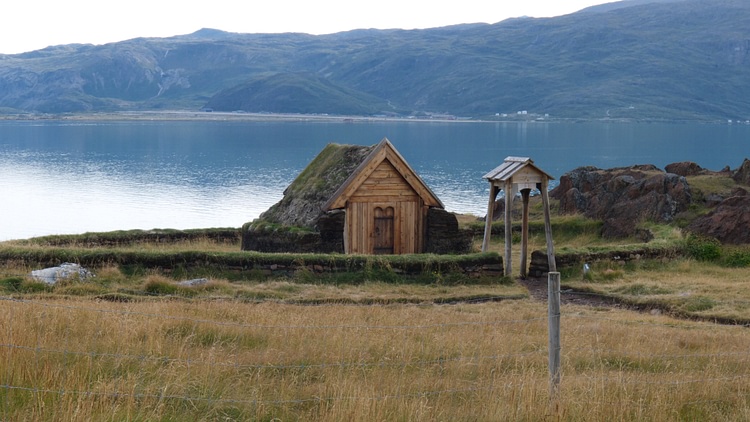
Around 75% of Greenland's immense surface – which totals around 1,350,000 square km, making it the world's largest island – is covered by inland ice, which gangs up with slabs of drift ice floating along the coasts to make any sane person think twice about moving there just for fun. Glaciers and mountains function as natural boundaries, making inland travel far from straight-forward. With a mostly arctic climate boasting mean temperatures below 10 degrees Celsius in the warmest months with only some of its areas poking above this, Greenland is not exactly ideal for growing such staples as grain, and there are few trees.
To survive these conditions, the Norse combined stock farming – grazing livestock – with the hunting of such creatures as seals and caribou, while also undertaking hunting trips further north to the northern hunting grounds (at Nordsetur, Disko Bay) to hack down walruses, narwhals, and even polar bears. Viking Age Greenlandic society was anchored in the many farms that dotted the settlements, with Christianity visibly present in the churches accompanying them. These farms also directly exported precious goods such as skins, hides, and walrus ivory abroad while importing luxuries as well as the necessary iron. Competition kept power spread out among a whole group of elite farmers, and no governmental body was present, but Greenland did formally come under Norwegian sway in 1261 CE.
This course kept the Norse Greenlanders afloat until in the course of the 15th century CE a mysterious silence kicked in and any word of them stopped reaching beyond their island. Among other factors, the climate turning colder (by courtesy of the so-called Little Ice Age, c. 1300 - c. 1850 CE) is generally seen to have played a role in their disappearance. When in 1721 CE Norwegian missionary Hans Egede was the first to successfully navigate the drift ice since the silence and actually reach Greenland's former Western Settlement, he found Inuit there but no sign of the Norse.
Discovery & initial settlement
With Iceland settled by Norse Vikings in the course of the 9th century CE, the North Atlantic was becoming familiar to them. Soon after, knowledge of new lands further west began to trickle in, first by way of Gunnbjörn Ulfsson whose ship was blown off course to within sighting range of Greenlandic islands (at an unknown date), and we know that in 978 CE, Snæbjörn Galti undertook an expedition in that direction, too, but that it turned into a disaster.
The first Viking to actually land on Greenland with his heart still beating – as far as we know – was Erik the Red. After being exiled from Iceland for murder around 982 CE, he skirted the southern tip of Greenland to land in what would become the Eastern Settlement (Eystribyggð in Old Norse), in a fjord he confidently named Eriksfjord. He is the one credited with coining the name Greenland, according to The Saga of Erik the Red, because he thought that "people would be attracted to go there if it had a favourable name" (2, as found in The Sagas of Icelanders, 654). He went back to Iceland in 985 or 986 CE, hustling up people for a second expedition to Greenland. With several days of sailing in difficult conditions, it was a tough journey as the Landnámabók (Book of Settlements) states: "twenty-five ships sailed to Greenland from Breiðafjörður and Borgarfjörður, fourteen reached it, some were driven back and some were lost." (The Oxford Illustrated History of the Vikings, 118). The settlement had begun.
With its eastern shore a frozen wasteland, the appeal for the Norse was in Greenland's inner southwestern fjords and surrounding coastal lands, which are, in fact, green and liveable – even similar to Norway in terms of landscape, if not climate – with the right subsistence strategies and the right amount of stubbornness. As Iceland was getting a bit crowded for landowners, the vast wilderness of Greenland must have been appealing to those seeking to carve out their own holdings.
The initial wave of Viking colonists was made up mostly of chieftains and rich farmers who owned their own ships and is thought to have numbered around 500 individuals. In an era known as the landtaking (landnám), they set up stock farms with the domestic animals they had brought along on their ships in the inner fjords where land was comparatively fertile. In the Western Settlement (Old Norse: Vestribyggð), which was founded around the same time in what is now the Nuuk region further north along the west coast, the environment was a bit too hostile for a proper pasture economy but offered plenty of land as well as marine hunting, for instance in the shape of unsuspecting seals. It also became the launching pad for expeditions to North America ('Vinland'), where Leif Erikson, Erik the Red's son, founded a Viking settlement in Newfoundland.
Farming
There is evidence for around 500 farms in the Eastern Settlement, whereas the Western Settlement counted maybe 100. These were not necessarily in a state of continuous operation; some were in use only periodically depending on the state of the vegetation. The Norse community in Greenland is estimated to have averaged around 1,400 people, with a peak of over 2,000 individuals around 1200 CE.
For these farms, it was all about location, with settlers looking for moraine plains close to the fjords as well as sheltered valleys with fertile land. Erik the Red, who obviously had first pick, built his farm at Brattahlíð (in the Eastern Settlement) in what is still an absolute prime farming location in Greenland, sitting snugly at the inner section of a fjord safeguarded from the outlying coastal fog and freezing waters. Higher elevations, by contrast, would have been easy prey to the elements, but one could still survive when focusing more on hunting.
Cattle, sheep, and goats – all shipped in – adjusted to Greenlandic conditions and were kept mostly for their milk and the subsequent cheese and butter, with sheep's wool coming in handy too. Although cattle had to be kept inside for many months, sheep and goats managed to survive outside. The farms were run in an infield-outfield system, with grazers chewing away at the outfields over the summer while the infields were manured or even irrigated in the growing season. Most of the meat came from hunted caribou and seals, although some of the larger farms also relied on their cattle herds.
After the more uniform settlement period, farms diversified: larger, high-status farms championed longhouses and the buildings were fairly scattered, while smaller farms were more centralised and kept their houses, cowsheds, stables and barns so closely huddled together one could move from one into the next without having to go outside – a response to climate change. The larger farms often also grabbed the better spots with the best yields, thus increasing their wealth, enabling them to keep prestigious but otherwise fairly useless cattle and cement their place in the elite with additions such as celebration halls and churches. Farms of all sizes seem to have been self-sufficient, though, making good use of hunting opportunities rather than relying solely on their livestock.
Hunting & Trade
The Norse Greenlandic economy was rooted in this combination of pastoral farming with hunting and also some fishing. Besides neighbourhood hunts and trips to the coast to hunt migratory seals in spring and autumn, both individual farms and groups of farmers banding together organised summer hunting trips way up north to Disko Bay where walruses, narwhals, and polar bears could be found. Here, they acquired precious skins, hides, and ivory. These were used in the local society itself to make garments and shoes but also as a form of currency, but they also formed the most important export commodities, as relayed by the 13th-century CE King's Mirror which describes Greenland's contact with the outside world around the start of the century:
Every item, with which they might help the country, they must buy from other countries, both iron and all the timber with which they build houses. People export these goods from there: goatskins, ox-hides, sealskins and the rope…which they cut out of the fish called walrus and which is called skin rope, and their tusks… (King's Mirror 17)
The timber referred to was only used for building those parts of houses that could not be built in stone; especially in the later settlement, buildings were either purely made of stone or of stone and cut turfs. From what the Icelandic sagas tell us, it seems trade was a decentralised affair, with foreign traders landing near large farms, lodging there and trading directly with the locals, through whom the goods were then further distributed. This gave the large farms even more leverage, and there is evidence of payments being made to the biggest farms at, for instance, Gardar, Erik's Brattahlíð, and Sandnes. As such, a monetary economy never became a thing in Norse Greenland; controlling trade was the road to power.
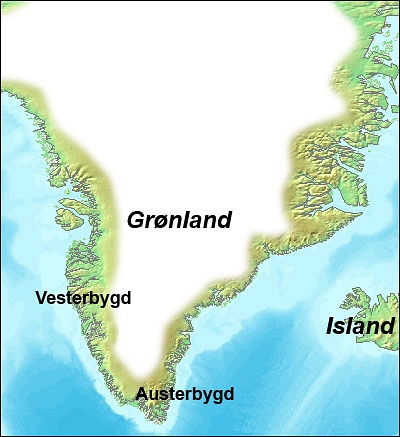
Walrus ivory, in particular, did exceptionally well on the Northern European markets, and during the settlement period, Greenlanders would sail to Europe with their goods on their own private ships. However, when, from 1261 CE on, Greenland became subjected to Norway's power it was the Norwegian merchants who took over. At first, this ensured traffic continued between Norway and Greenland, but from the late 14th century CE onwards, the numbers of Norwegian ships sailing to Greenland dwindled heavily, only to cease entirely in the late 15th century CE.
The Church
The Norse settlements in Greenland appear to have been Christian basically from the get-go; not a single pagan grave has been unearthed, and there is evidence of churches that were built in the immediate settlement period. The Saga of Erik the Red bolsters the archaeological record in claiming that Leif Erikson was tasked by the Norwegian king Olaf Tryggvason (r. 995-1000 CE) with bringing Christianity to Greenland c. 1000 CE. Since Greenland was settled from Iceland, which became Christian by law in 1000 CE with conversions having picked up since Olaf Tryggvason's ascension to the Norwegian throne, it is hardly a stretch to assume the pioneering Norse sailing to Greenland would have ferried Christianity across the sea with them.
In later Greenlandic society, churches and burial grounds were always connected to farms, and it is assumed that even the first settling families might have adhered to this practice too. As in Iceland, churches were most likely privately owned by farmers, which would have given the owners an extra source of income. Over time, a shift can be seen from a multitude of small churches to fewer but larger churches, perhaps showing an increasing concentration of power in the hands of elite farmers.
Major parish churches have been found at Sandnes, undir Höfða, and Herjólfsnes, while a monastic church or convent stood at Narsarsuaq, but it was not until the 12th century CE that a bishop's see was established in Greenland, at Gardar, where a cathedral church was constructed on what was already the biggest farm on the island. This was a result of Norwegians poking their noses into Greenlandic business, and as far as the written sources tell us, the bishopric was only ever held by outsiders.
Probably hindered by the aggressively middle-of-nowhere location and the pesky amount of privately owned churches, the Roman Church struggled to gain much influence in Greenland throughout the settlement period in particular. In Iceland, where there were some similarities to the situation, the established church amped up the pressure in the 13th century CE, but Greenland's fate in this matter remains mysterious.
Contact with the Dorset & Thule cultures
Of course, the Norse were not the only one people both stubborn and skilled enough to adapt to Greenland's decidedly special conditions; already in the 8th century CE the late Dorset Palaeo Eskimos had made their way to the Greenlandic side of the Nares Strait/Smith Sound region which lies between Greenland and Canada's Ellesmere Island. Around 1200 CE, the Thule culture people (the ancestors of the Inuit) joined in too, trekking from Alaska through Canada to Greenland and meeting the Dorset people in the Smith Sound region between c. 1200-1300 CE. The Dorset culture was in decline at this point and was replaced by the surging Thule culture.
During this time, the Norse undertook expeditions to the northern hunting grounds, too, and may have bumped into both of these cultures, as Jette Arneborg explains:
Archaeological finds and written sources indicate some interaction between the Dorset, Thule and Norse people; the nature of the contacts is however hardly known, but written sources indicate Norse interest in the skrælings [an Old Norse term for these peoples] and one explanation could be the exchange of commodities. The Norse may have acquired walrus ivory from the Palaeo Eskimo and Inuit hunters in return for metals. The majority of Norse finds found in Thule culture context are metals. (Viking World, 594)
Artefacts from these cultures have been found in Viking contexts, and vice versa, which probably indicates they traded with each other, but to what extent is hard to figure out. It seems the commodities acquired from the Dorset and Thule cultures did well abroad and were mostly exported by the Vikings.
The Thule people expanded further across Greenland, reaching the Scoresby Sound on the east coast by c. 1300 CE and subsequently scooting further south and southwest later in the 14th century. The Vikings' Western Settlement was reached by the mid-14th century, roughly coinciding with the last signs of the Norse in that region; this would later spark theories of the Thule people having had a hand in the Norse's demise, but this has by now been dismissed. The Thule people also came close to the Eastern Settlement around this time, possibly living along the outer coastal area of the region while the Norse occupied the inner fjords, but only for a generation or two.
Mysterious demise
During the 14th and 15th centuries CE, something went terribly wrong for the Norse Greenlanders. The last written evidence we have of them stems from 1424 CE when a Greenlandic priest wrote a letter in which he verified to have been present at the wedding of a young couple in Hvalsey fjord (in the Eastern Settlement) in 1408 CE, after which a deafening silence sets in. Remains of burials show signs of life until around 1450 CE for the Eastern Settlement, while the written- and the archaeological record suggests the Western Settlement collapsed into ghost-town status already a century before, in the mid-14th century CE.
Around this time, the drift ice around Greenland had become so fiercely annoying that no one succeeded in reaching the island until the Norwegian missionary Hans Egede made land at the former Western Settlement in 1721 CE. Here, he found only Inuit and no Norsemen. Early theories to explain their disappearance revolved around imagined conflict with the Inuit, Greenland's isolation from the perceived safety blanket that was Europe, and even inbreeding supposedly ruining the originally fine physical specimens that were the Vikings, but have since been discarded for lack of evidence.
Cue the climate change argument, which became the most long-lived single explanation and ascribes the Little Ice Age which affected Greenland from the 14th century CE (until c. 1850 CE) the touch of death. Glaciers expanded, temperatures dropped, and the wind picked up, which, considering the already overexploited state of vegetation, helped lead to erosion while rising sea levels also nibbled away precious grassland. Sea ice would also have lunged in and out of Greenland's shores, affecting both trade and hunting. Even in the snugly sheltered fjords of southern Greenland which are normally boosted by warm sea currents, the effect was felt. Skeletons show the Norse were directly impacted by this change in climate and a shift to a more marine diet is visible, too. Overall, the Little Ice Age must have had a fair impact on the Norse Greenlanders.
However, the story cannot have been that simple; the Little Ice Age was not a state of constant refrigeration but came in waves, and the Inuit were fine throughout all of it, indicating culture could make a difference, here, too. Unlike the Norse, the Inuit also hunted ring seals through breathing holes in the winter ice using their advanced harpoon-hunting technology and made use of larger parts of Greenland than did the Norse, who remained dependent on their farms and pastures. These were, of course, more vulnerable to cold snaps, and the archaeological record shows that the occupants of at least some farms died or starved rather than emigrating. Some may have emigrated, though, with more lands being available in Europe in general due to depopulation (some of it thanks to the plague in 1348 CE, which probably at least indirectly affected Greenland too by falling export prices and maybe even directly). Scholars agree, though, that rather than there having been one single perpetrator, the Viking Age in Greenland must have ended through a combination of factors such as these.
